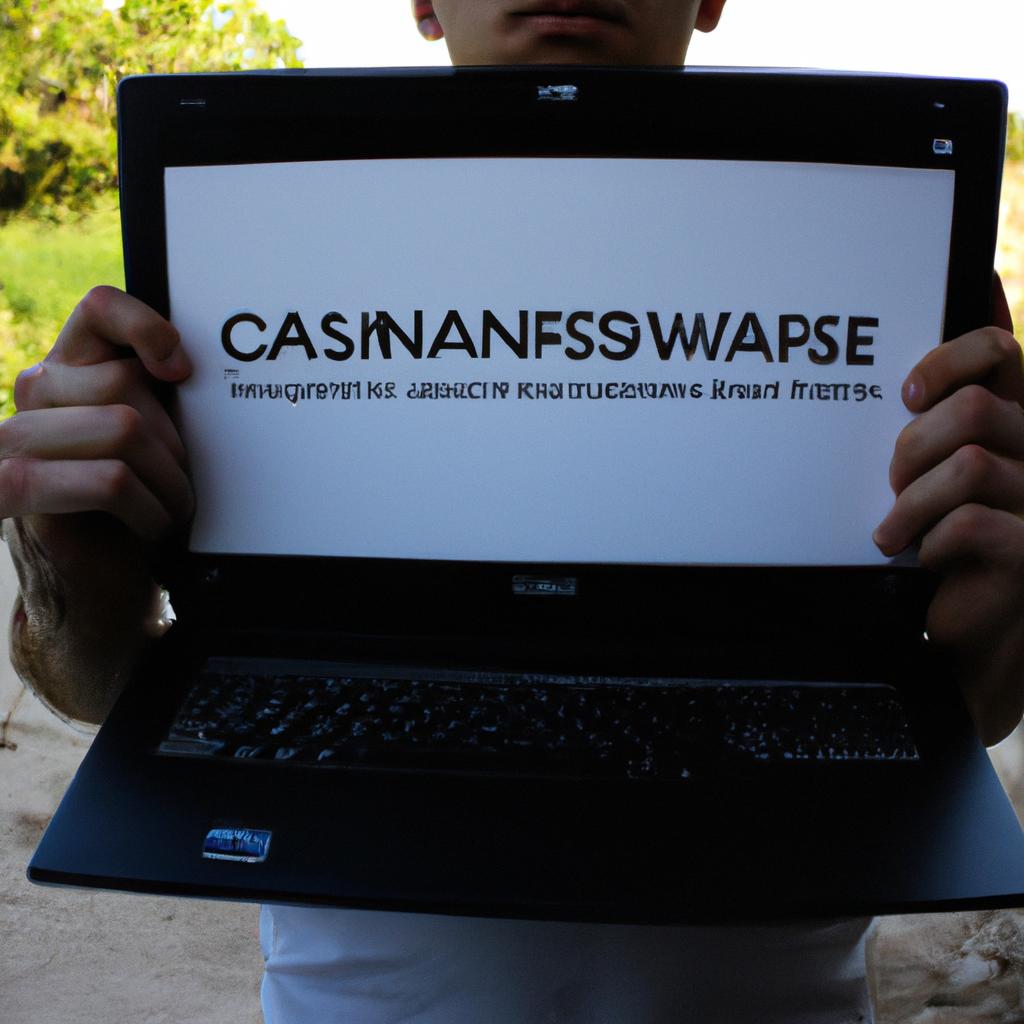In the ever-evolving world of online security, phishing has emerged as a pervasive threat to individuals and organizations alike. The term “phishing” refers to cybercriminals’ deceptive tactics aimed at tricking unsuspecting victims into divulging sensitive information such as login credentials, financial details, or personal data. While traditional phishing methods have been widely studied and recognized, there exists a lesser-known yet equally dangerous variant known as vishing. Vishing combines voice technology with social engineering techniques to manipulate individuals over the phone, posing significant risks that demand attention and understanding.
To illustrate the potential dangers of vishing, let us consider a hypothetical scenario involving an individual named Alex. One day, Alex receives a call from someone claiming to be a representative from their bank. The caller speaks in a calm and authoritative manner, informing Alex that suspicious activity has been detected on their account and immediate action is required to prevent further damage. To validate their identity and gain trust, the caller accurately cites specific transactions made by Alex recently. Fearing for their financial well-being, Alex complies with the instructions provided over the phone without realizing they have fallen victim to vishing – divulging confidential information that will later be misused by malicious actors.
While this example may seem fictional, it is unfortunately a very real and common occurrence in today’s digital landscape. Vishing attacks are becoming increasingly sophisticated, with attackers employing various tactics to manipulate and deceive their victims. These include spoofing caller IDs to make it appear as if the call is coming from a trusted source, using advanced voice technology to mimic legitimate individuals or automated systems, and even gathering personal information from social media platforms to personalize the conversation and increase credibility.
The consequences of falling victim to vishing can be severe. Attackers can use the obtained information for identity theft, financial fraud, or gaining unauthorized access to sensitive accounts. Furthermore, vishing attacks can also serve as a gateway for other types of cybercrimes such as phishing emails or malware distribution.
To protect oneself against vishing attacks, it is crucial to remain vigilant and follow best practices:
-
Be skeptical: Always question unexpected calls requesting personal or financial information. Legitimate organizations will never ask for sensitive details over the phone.
-
Verify independently: If you receive a suspicious call claiming to be from your bank or any other institution, hang up and contact them directly using official contact information from their website or verified sources.
-
Do not provide personal information: Never share passwords, PINs, social security numbers, or any other confidential data over the phone unless you have initiated the call and are certain about the legitimacy of the recipient.
-
Educate yourself: Stay informed about new techniques used by scammers and regularly update your knowledge on cybersecurity best practices.
-
Enable call-blocking features: Many smartphones offer built-in features that allow users to block specific callers or unknown numbers.
By staying cautious and implementing these preventive measures, individuals can significantly reduce their risk of falling victim to vishing attacks and help create a safer online environment for everyone.
What is Vishing?
Imagine receiving a phone call from what appears to be your bank, informing you that there has been suspicious activity on your account. The caller seems legitimate, providing detailed information about your recent transactions and even using the correct terminology associated with banking procedures. They urgently request your personal identification number (PIN) to verify your identity and resolve the issue promptly. This scenario represents an increasingly common form of cybercrime known as vishing.
Vishing, short for voice phishing, refers to the act of manipulating individuals through fraudulent phone calls to deceive them into sharing sensitive information or performing actions that compromise their security. It typically involves impersonating trusted entities such as financial institutions, government agencies, or reputable companies. By exploiting social engineering techniques and preying on human vulnerabilities, attackers aim to gain access to personal data like credit card numbers, login credentials, or other confidential information.
To understand the dangers of vishing more comprehensively, it is essential to highlight its key characteristics:
- Impersonation: Attackers skillfully pose as authoritative figures or organizations in order to gain victims’ trust.
- Urgency: Vishing attempts often create a sense of urgency or fear by claiming immediate consequences if action is not taken.
- Spoofing: Callers may use advanced technology to manipulate caller ID systems, displaying fake numbers or making it seem like they are calling from a familiar source.
- Manipulation: Vishing relies heavily on psychological manipulation tactics aimed at eliciting emotional responses from victims.
| Emotional Response | Example |
|---|---|
| Fear | Feeling threatened by potential consequences if requested actions are not taken immediately |
| Trust | Believing the caller’s claim due to their ability to provide accurate personal details |
Understanding these emotional responses can help individuals recognize and resist vishing attacks effectively. By being aware of these manipulative strategies employed by attackers, one can take necessary precautions to protect themselves and their personal information.
In the subsequent section, we will explore the evolution of vishing attacks and how cybercriminals have adapted their techniques over time. By understanding these advancements, individuals can better prepare themselves against this ever-evolving threat landscape.
The Evolution of Vishing Attacks
As online security measures have improved, cybercriminals have adapted their tactics to bypass these defenses. One such adaptation is the evolution of vishing attacks, a form of social engineering that combines voice communication and phishing techniques. To illustrate the growing threat of vishing, consider the following hypothetical scenario:
Imagine you receive an urgent phone call from your bank claiming that there has been suspicious activity on your account. The caller asks for personal information, including your Social Security number and credit card details, under the guise of verifying your identity. Unbeknownst to you, this is a vishing attack designed to steal sensitive data.
Vishing attacks leverage psychological manipulation to exploit human vulnerabilities. Here are some key points regarding the evolution of vishing attacks:
- Increased sophistication: Cybercriminals continuously refine their strategies by using advanced technology and exploiting advancements in artificial intelligence (AI) to make their calls seem more legitimate.
- Personalized approach: Attackers often gather information about their targets through various means, such as social media profiles or previous data breaches, allowing them to personalize their messages and gain trust.
- Impersonating trusted entities: Vishing attackers frequently pose as representatives from reputable organizations like banks, government agencies, or service providers. By impersonating these trustworthy sources, they increase the likelihood of victims falling into their trap.
- Exploiting fear and urgency: Vishing scams commonly create a sense of urgency or fear in potential victims. They rely on emotions such as panic or concern to manipulate individuals into divulging confidential information quickly.
These evolving tactics demonstrate the need for increased awareness and caution when it comes to protecting oneself against vishing attacks. In the subsequent section on “Common Vishing Techniques,” we will delve deeper into specific methods employed by cybercriminals in carrying out successful vishing campaigns. Understanding these techniques can empower individuals with knowledge needed to identify and resist these fraudulent schemes effectively.
Common Vishing Techniques
Building upon the evolution of vishing attacks, it is crucial to explore the common techniques employed by attackers. By understanding these tactics, individuals can better equip themselves against falling victim to such fraudulent activities. To illustrate the importance of this knowledge, let us consider a hypothetical case study involving an unsuspecting individual who became a target.
Vishing attacks often rely on various manipulative strategies to deceive victims and gather sensitive information. Understanding these techniques will enable individuals to identify potential threats more effectively:
-
Caller ID Spoofing:
- Attackers manipulate caller identification systems to display false numbers or legitimate organizations’ phone numbers.
- This technique creates a sense of authenticity and leads victims to believe they are receiving calls from trusted sources.
-
Social Engineering:
- Exploiting human psychology, attackers employ social engineering techniques such as creating a sense of urgency or fear.
- By evoking strong emotions, scammers manipulate victims into providing personal information without hesitation.
-
Impersonation:
- Attackers may impersonate authoritative figures, such as law enforcement officers or bank representatives.
- This tactic aims to gain the trust of victims and convince them that disclosing confidential data is necessary for their own security.
-
Voice Manipulation:
- Using voice-altering technologies or pre-recorded messages, attackers mimic official voices associated with reputable institutions.
- Victims are less likely to question the legitimacy of the call when confronted with familiar-sounding voices.
| Vishing Technique | Description |
|---|---|
| Caller ID Spoofing | Manipulating caller identification systems to display false numbers or legitimate organizations’ phone numbers, creating a sense of authenticity and leading victims to believe they are receiving calls from trusted sources. |
| Social Engineering | Exploiting human psychology by evoking strong emotions such as urgency or fear, scammers manipulate victims into providing personal information without hesitation. |
| Impersonation | Impersonating authoritative figures like law enforcement officers or bank representatives in order to gain the trust of victims, convincing them that disclosing confidential data is necessary for their own security. |
| Voice Manipulation | Using voice-altering technologies or pre-recorded messages to mimic official voices associated with reputable institutions, making it less likely for victims to question the legitimacy of the call when confronted with familiar-sounding voices. |
Recognizing Vishing Attempts:
Moving forward, individuals must educate themselves on how to identify vishing attempts and protect against falling prey to these deceptive tactics. By recognizing the warning signs and developing a proactive approach towards online security, one can effectively safeguard their sensitive information and mitigate potential risks.
Recognizing Vishing Attempts
Section: Recognizing Vishing Attempts
Imagine receiving a phone call from what appears to be your bank. The caller, claiming to be a customer service representative, informs you that there has been suspicious activity on your account and urgently requests your personal information to verify your identity. This scenario is an example of vishing, one of the most prevalent techniques used by cybercriminals to deceive individuals into divulging sensitive information over the telephone.
To protect yourself against such attempts, it is crucial to recognize common signs of vishing attacks. Here are some indicators that can help you identify potential vishing attempts:
- Caller ID Spoofing: Attackers may manipulate their caller IDs to display familiar numbers or appear as legitimate organizations.
- Urgent Requests for Personal Information: Fraudsters often create a sense of urgency in their calls, pressuring victims to disclose confidential details immediately.
- Threats or Rewards: Scammers may employ intimidation tactics like threats of legal action or offer enticing rewards to coerce victims into sharing sensitive data.
- Poor Call Quality or Background Noise: As many attackers operate from unprofessional environments, background noise or poor call quality might indicate fraudulent intent.
Understanding these telltale signs can significantly enhance your ability to detect vishing attempts and safeguard your personal information. To further facilitate recognition, consider the following table detailing additional red flags commonly associated with this type of attack:
| Signs of Vishing Attempts | Explanation |
|---|---|
| Unsolicited Calls | Unexpected calls asking for personal information should raise suspicion. |
| Request for Financial Data | Legitimate organizations rarely ask for credit card or banking details over the phone. |
| Pressure Tactics | Fraudsters often use aggressive language or threaten dire consequences if demands aren’t met. |
| Unfamiliarity | Impersonators may lack specific knowledge about the victim’s accounts or recent transactions. |
By being aware of these warning signs and understanding the tactics employed by vishing attackers, you can take proactive measures to protect yourself from falling victim to their schemes. In the subsequent section, we will delve into strategies and best practices that will assist you in safeguarding your personal information against these malicious activities.
Transitioning seamlessly into the next section about “Protecting Yourself from Vishing,” let us now explore effective methods for preventing these deceptive attacks.
Protecting Yourself from Vishing
Building off our previous discussion on vishing and its hidden dangers, let us now delve deeper into the art of recognizing vishing attempts. To better understand this concept, consider the following hypothetical scenario: Sarah receives a phone call from someone claiming to be her bank’s representative. The caller informs her that there has been suspicious activity detected on her account and requests sensitive information such as her social security number and online banking credentials.
To protect yourself from falling victim to these cunning tactics, it is essential to be aware of common signs that indicate a potential vishing attempt. These signs include:
-
Urgency: Vishing scammers often create a sense of urgency or fear to pressure their targets into providing personal information. They might claim your account will be closed or frozen unless you act immediately.
-
Caller ID Spoofing: Vishing perpetrators may manipulate caller IDs to make it appear as if the call is coming from a legitimate source, such as a bank or government agency. However, it is important to remember that caller IDs can easily be falsified.
-
Requests for Personal Information: Legitimate organizations typically do not ask for personal information over the phone, especially sensitive data like Social Security numbers or passwords. Be cautious when asked for such details during unsolicited calls.
-
Unusual Call Behavior: Pay attention to any unusual behavior during the call, such as background noise indicating an unprofessional setting or repeated redirections when asking for verification purposes.
By familiarizing ourselves with these warning signs and remaining vigilant while communicating over the phone, we can significantly reduce our susceptibility to vishing attacks.
| Warning Signs |
|---|
| Urgent demands for immediate action |
| Manipulated caller ID display |
| Solicitation of personal information |
| Suspicious call behavior |
In conclusion, being able to recognize vishing attempts empowers individuals in safeguarding their personal information and financial well-being. By identifying the warning signs, such as urgency or requests for personal information, we can actively protect ourselves from falling victim to these devious schemes.
Reporting Vishing Incidents
Having explored effective measures for protecting oneself from vishing attacks, it is crucial to understand the various tactics employed by perpetrators in order to recognize and respond effectively. This section delves into the deceptive strategies used by cybercriminals in vishing attacks, shedding light on their modus operandi.
Case Study: Imagine a scenario where an unsuspecting individual receives a phone call purporting to be from their bank’s customer service department. The caller introduces themselves as a representative seeking verification of personal details due to suspicious activity on the account. In an attempt to instill urgency and fear, they claim that failure to comply will result in immediate suspension of the account. Despite initial skepticism, the victim discloses sensitive information such as their full name, date of birth, social security number, and even online banking credentials.
Vishing attackers employ several techniques aimed at manipulating victims’ emotions and creating a sense of urgency or trustworthiness:
- Impersonation: Attackers often pose as authoritative figures or trusted entities like banks, government agencies, or well-known companies.
- Social Engineering: By leveraging psychological manipulation tactics, criminals exploit human vulnerabilities such as fear, curiosity, or desire for financial gain.
- Spoofing Caller ID: To appear legitimate and trustworthy, fraudsters manipulate technology to display false caller identification information.
- Data Mining: Prior research enables attackers to gather personal information about potential targets through various means including social media platforms and data breaches.
Table: Emotional impact of falling victim to a vishing attack
| Emotion | Physical Response | Psychological Response |
|---|---|---|
| Fear | Increased heart rate | Heightened anxiety |
| Anger | Elevated blood pressure | Frustration |
| Embarrassment | Flushing or blushing | Humiliation |
| Guilt | Stomach discomfort | Self-blame |
Recognizing the severity of vishing attacks and their potential consequences, it is essential to remain vigilant. By familiarizing oneself with these tactics and understanding the emotional impact of falling victim to such fraud, individuals can enhance their ability to detect suspicious calls and protect themselves from becoming unwitting victims.
Note: The information provided in this section serves as an academic analysis and does not intend to endorse or promote any illegal activities associated with vishing attacks.









